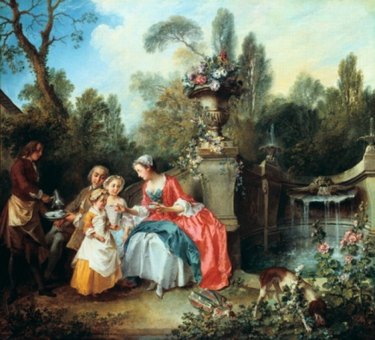
Properly made oil paintings are durable, moisture-resistant and capable of standing up to hundreds of years of use. However, the wrong materials or the wrong painting technique could lead to problems. Some oil paintings flake, bubble and crack. This condition, called delamination, occurs when the individual layers of paint peel apart from one another or from the substrate or ground. This problem can have several causes.
Ground
Video of the Day
Traditionally, oil paintings used a ground of rabbit skin glue combined with ground marble or chalk. This ground was called gesso, and produced a smooth, white, inflexible painting surface. On panel paintings, rabbit skin grounds cause few problems. However, on canvas paintings, they tend to be less flexible than the canvas and the oil paint, sometimes causing cracking and other problems. Modern acrylic grounds use a fine white pigment in an acrylic plastic binder. This material is more flexible, but can still cause delamination. According to Queen's University, oil paints that contain metal soaps peel and bubble away from acrylic grounds over time.
Video of the Day
Medium
All oil paint requires a medium. Simple oil painting mediums are made up of linseed oil or linseed oil and resin. However, more complex mediums can provide special benefits, such as fast drying times or smoother painting. Some specialty mediums produce attractive results and easier painting, but are considered non-archival over time. They contribute to painting cracking and delamination. These include Maroger medium, an early-20th-century lead-based painting medium that produces slick strokes but peeling paintings, and lead napthanate mediums. Avoid using these fast-drying materials for more archival paintings. Oil-modified alkyd mediums also sometimes caused delamination, especially in multi-layer paintings.
Technique
Even very traditional oil paintings on panels, or paintings made using very stable mediums, can delaminate if improperly layered. All oil paint must be applied following the rule of "fat over lean." Some pigments, such as burnt umber, absorb less oil than others, producing a less flexible film. Fat over lean painting uses more oil in subsequent layers, and places the less absorbent pigments in the lower layers. This prevents a flexible underlayer from shifting and cracking an inflexible top layer. Applying thick layers of paint over thinner layers also produces less cracking and delamination than using glazes over thick paint.
Conservation
Repairing a delaminated painting can be very difficult. According to J.M. Culver, a mixture of damar resin and beeswax, applied to the canvas, can help reattach flaking paint to its ground. This repair medium should be heated, diluted with turpentine and brushed onto the flaking area carefully. Flatten the flaking paint with a heated palette knife, then paste paper over the area once it has dried. Apply the damar mixture to the back of the canvas, then iron the area using an electric iron. Once this cools, wash the paper away. Some conservation experts also use epoxy, a non-shrinking material, to glue down flaking paint. However, epoxy is more permanent than the damar mixture. When in doubt, take the damaged painting to a professional for conservation.